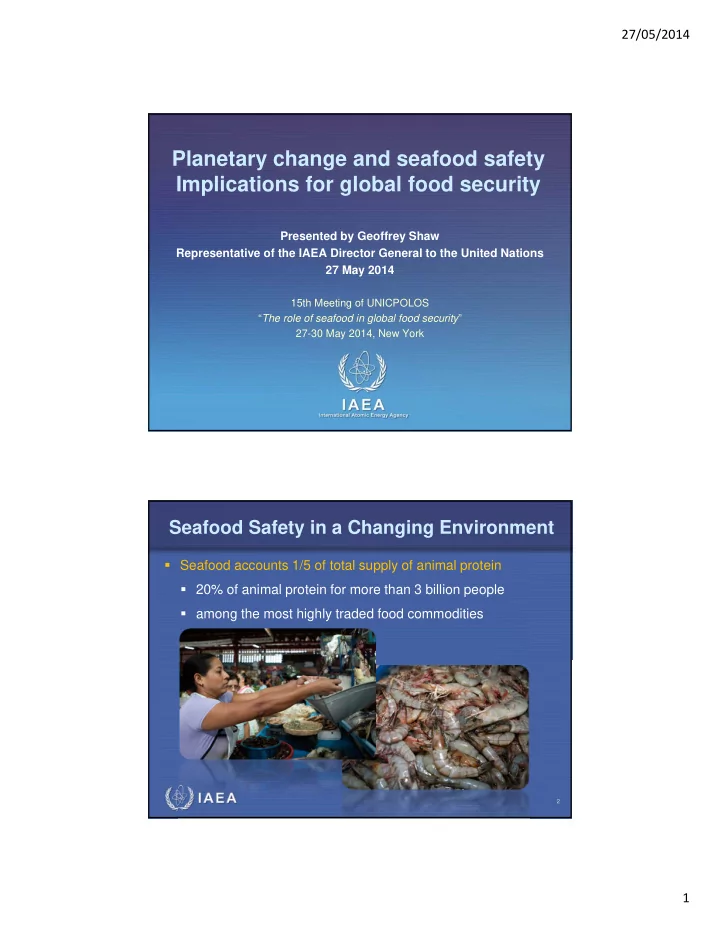

27/05/2014 Planetary change and seafood safety Implications for global food security Presented by Geoffrey Shaw Representative of the IAEA Director General to the United Nations 27 May 2014 15th Meeting of UNICPOLOS “ The role of seafood in global food security ” 27-30 May 2014, New York IAEA International Atomic Energy Agency Seafood Safety in a Changing Environment Seafood accounts 1/5 of total supply of animal protein 20% of animal protein for more than 3 billion people among the most highly traded food commodities IAEA 2 1
27/05/2014 Seafood Safety Environmental factors affecting seafood safety Pollution Marine Toxins / Harmful Algal Blooms (red tides) Climate change and ocean acidification How is the IAEA helping MS tackle the problem? Advance science and to build capacity o nuclear and isotopic techniques Framework of strategic partnerships o IOC-UNESCO, UNEP, IMO, National Labs IAEA 3 Nuclear and Isotopic Technologies Nuclear techniques: detection of radioactive isotopes e.g. carbon-14 used for dating archives Isotopic techniques: detection of stable isotopes e.g. carbon-13 used to identify trophic levels along a food chain Comparative advantage over other techniques: high sensitivity / low detection limit radioactive decay (“internal clock”) allows dating ratios of stable isotopes - determine past environmental conditions stable isotopic fingerprint allows identifying source of pollution IAEA 4 2
27/05/2014 What is the IAEA doing? Advice on seafood protection radioactive and non-radioactive contaminants Application of nuclear/isotopic techniques pollutants; HABs; OA Research and Development environmental stressors Capacity building analytical capacity of marine labs IAEA 5 Types of Marine Pollution Radionuclides Cesium-137, Americium-241 o e.g. nuclear testing, nuclear accidents Organic and inorganic contaminants toxic metals persistent organic pollutants litter / plastics IAEA 6 3
27/05/2014 IAEA Efforts to Tackle Pollution Laboratory and field studies organisms and their environment o pollutant dispersion o behaviour in the environment o bioaccumulation IAEA 7 Harmful Algal Blooms Marine biotoxins produced by marine algae increased frequency and intensity Major public health and socioeconomic problem Toxic microalgae Transfer, bioaccumulation, biotransformation Beach closure Fisheries closure OR 1 R 2 3 C H O O Human illness/death CH 3 CH 3 CH 3 O CH O O 3 O O O O CH O 3 O O CH 3 IAEA 8 4
27/05/2014 IAEA Efforts to Tackle Harmful Algal Blooms Nuclear techniques measure HAB toxins in seafood study environmental and climatic changes on HAB occurrence and frequency Nuclear-based receptor binding assay (RBA) analysis of algal toxins early warning IAEA 9 Climate Change and Ocean acidification As atmospheric CO 2 concentration climbs, ocean pH falls extent of impact difficult to predict o affects ability of some marine life to build shells and skeletons potentially devastating in some fragile ecosystems o e.g. tropical coral reefs and polar regions o biodiversity, safety and security of seafood IAEA 10 5
27/05/2014 IAEA efforts to tackle Ocean Acidification – CRP: “Ocean Acidification and Economic Impacts on Fisheries” BRAZIL GHANA CO 2 effects on OA impacts on calcification* fisheries & [ 45 Ca] of mussel livelihoods larvae PHILIPPINES KENYA KUWAIT pH effects on fish OA impacts CO 2 effects on Kuwait eggs/larvae & on reefs, fish coral economic valuation of & livelihoods calcification* Arabian OA impact on fisheries [ 45 Ca] ; OA reef Gulf impacts CANADA USA Based on MEY of the Training in use of BCE NOAA collaboration in use of Rational modified Gordon- Model of OA effects on Expectations Models based on MEY in Schaefer model for fisheries for coupled bio- fisheries for OA impacts Bio-economics physical and socio- CASE STUDY economic factors of Bristol Bay King Crab CHILE Fishery upwelled CO 2 effects on adult mussel IAEA aquaculture 11 Ocean Acidification International Coordination Centre (OA-ICC) Hub: to communicate, promote and Advisory Board facilitate overarching activities on OA End Users: scientific community and science users e.g. policy makers, media, general public oaicc@iaea.org www.iaea.org/nael/OA-ICC www.iaea.org/ocean-acidification IAEA 12 6
27/05/2014 Recommendations to Improve Seafood Safety and Food Security Need for Strengthening: Science in support of decision-making more and accelerated science o Capacity building and transfer of knowledge expanded research, data generation o Collaboration / network of partners global, regional and national level o IAEA 13 Thank You IAEA 14 7
Recommend
More recommend